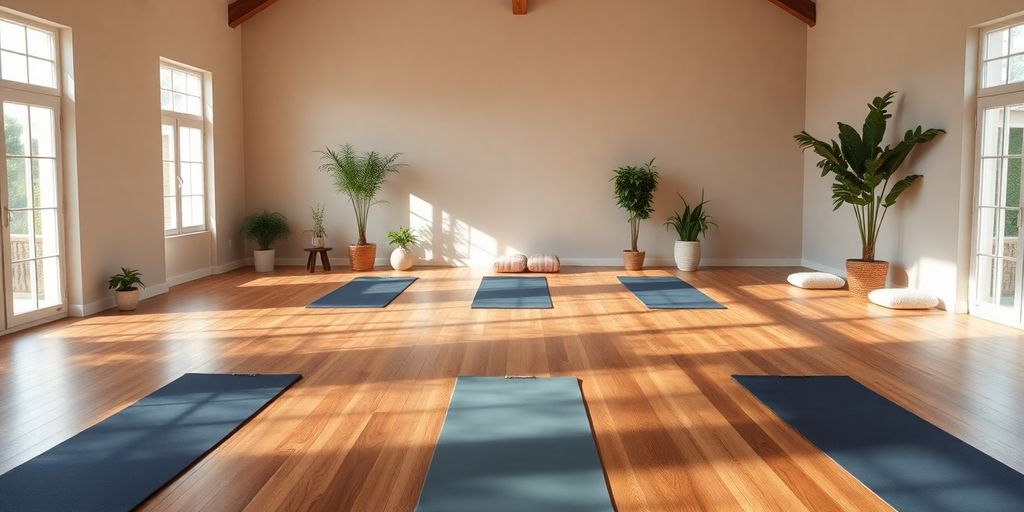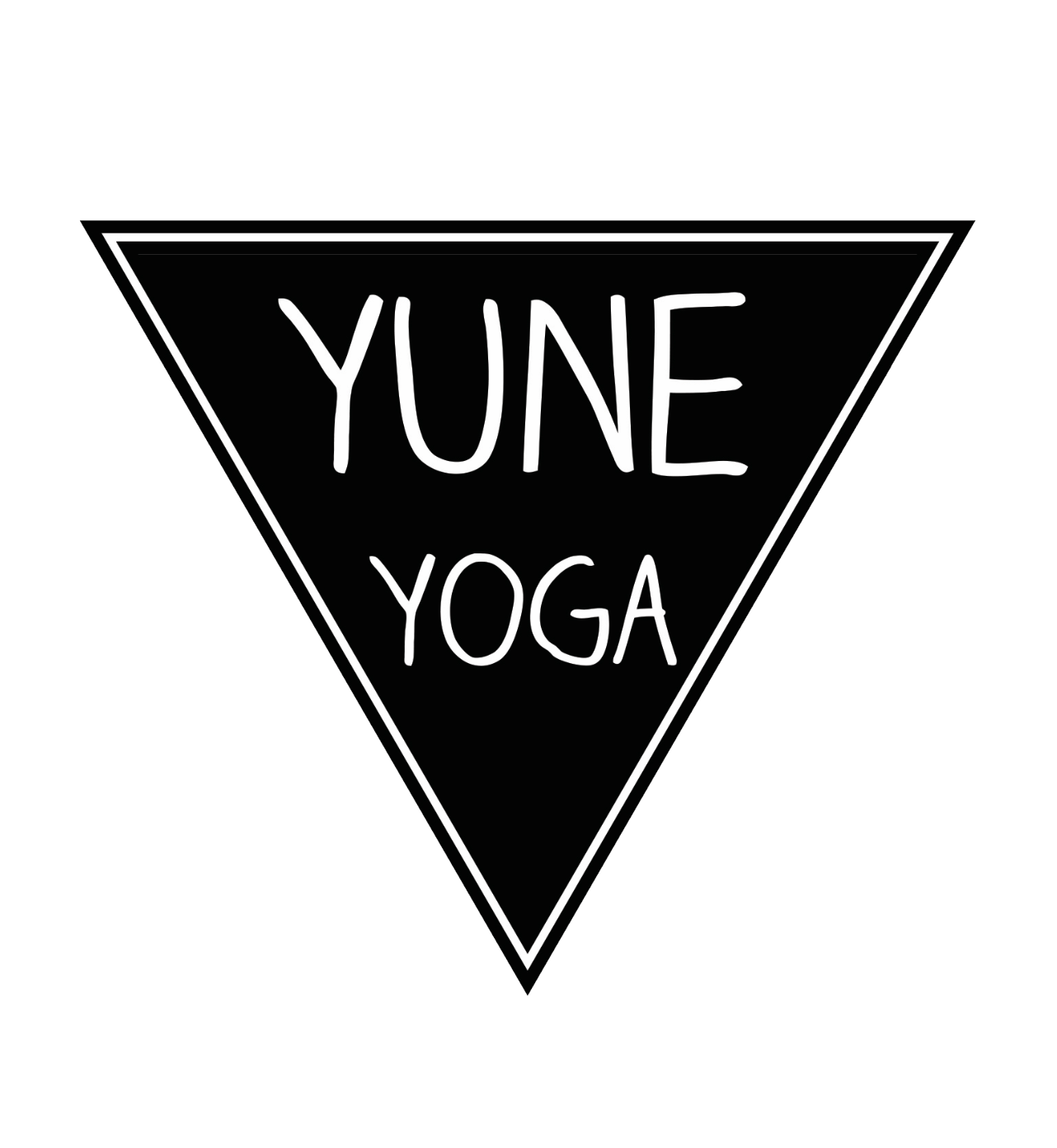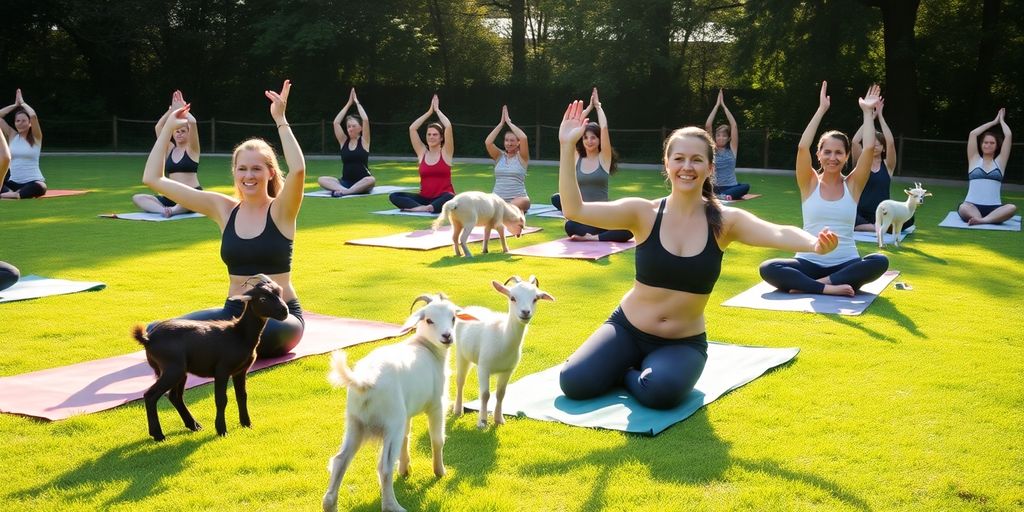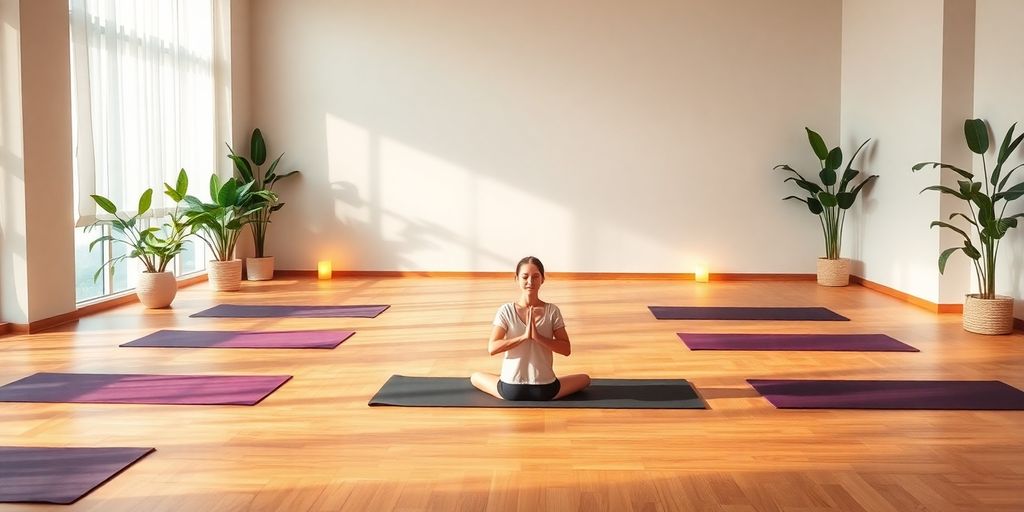
Discover the Best Yoga Teaching Training Near Me: Your Guide to Local Opportunities in 2025
Thinking about becoming a yoga instructor or just want to deepen your practice? You're in luck! In 2025, there are plenty of local yoga teaching training programs available that can help you on your journey. This guide will walk you through everything you need to know about finding the best yoga teaching training near me, so you can get started on the right foot.
Key Takeaways
- Local yoga teacher training programs offer community support and networking opportunities.
- Consider the qualifications of instructors when choosing a training program.
- Research the curriculum to ensure it aligns with your goals.
- Explore various yoga styles to find the right certification for you.
- Be aware of all costs involved, including hidden fees, when budgeting for training.
Exploring Local Yoga Teaching Training Options
Benefits of Local Training Programs
Local programs can offer more than just certification; they open up networking chances right in your area. These trainings build connections that last beyond the classroom. Some benefits include:
- Lower costs compared to traveling far for workshops.
- Immediate feedback during in-person sessions.
- A network of peers who share your passion.
Finding Yoga Studios Near You
Finding studios that host local training can be straightforward if you know where to search. Try these steps:
- Check out bulletin boards and local community centers.
- Attend trial sessions or open house events.
- Chat with local yoga enthusiasts who know the area well.
You might even come across studios offering affordable yoga training events, perfect for those keeping an eye on their budget.
Below is a quick table summarizing a few aspects of common local studio offerings:
| Studio Feature | Typical Duration | Cost Range |
|---|---|---|
| Evening Sessions | 6-8 weeks | $500 - $1500 |
| Weekend Retreats | 3-5 days | $300 - $800 |
| Intensive Workshops | 1-2 days | $200 - $600 |
Community Support in Local Training
When you choose a local program, you join a community that pulls together experience and support. Everyone shares tips, helps with challenges, and celebrates small wins together.
The encouragement from local practitioners makes the entire journey more personal and fulfilling.
Local community backing can be the extra nudge you need to start your teaching career with confidence.
Key Factors to Consider in Yoga Teaching Training
Instructor Qualifications
When you check out a yoga teacher training program, one of the first things to inspect is the background of its instructors. They should have real experience teaching different levels, and their credentials matter. Skilled instructors make the learning experience much clearer and more trustworthy.
It’s wise to ask about their previous teaching gigs and their personal practice. A mix of formal training and hands-on experience usually indicates a strong foundation. For a bit of extra peace about online safety, consider Cloudflare security checks when signing up for online components.
Curriculum Overview
A solid training course will offer a well-rounded curriculum. Look for lessons on body alignment, breathing exercises, and meditation techniques. A simple table can help paint the picture:
| Module | Topics Covered | Hours |
|---|---|---|
| Asana Basics | Posture, alignment, flow | 20 hrs |
| Breathing | Pranayama techniques | 10 hrs |
| Meditation | Mindfulness and focus | 5 hrs |
Reviewing the curriculum in detail can ensure you know what practice areas will be pushed. Items in a good syllabus may include lists like:
- Safe practice techniques
- Modification methods
- Philosophy and mindfulness insights
Training Formats Available
Not every training you see is offered in one format. Programs usually come in various styles so that you can choose what works best.
- In-person sessions where you get to experience a live, community-based atmosphere.
- Online classes that offer flexibility if you prefer studying at home.
- Hybrid options, which combine face-to-face and digital meetings, making it easier to meet your lifestyle needs.
Remember, the format you select can significantly impact your learning pace and overall satisfaction. Make the choice that suits your day-to-day reality.
By weighing these factors, you can better decide which yoga teaching training will match your style. The road might be a bit bumpy, but a thoughtful choice leads to a more rewarding journey.
Popular Yoga Styles for Teaching Certification
When choosing a yoga style to get certified in, it's important to understand what each approach offers. The learning process can be challenging but fun, and each style has its own unique flavor that can complement your teaching journey. Below, we break down some well-known styles.
Hatha Yoga
Hatha yoga is known for its slower pace and focus on alignment. This style is often viewed as a great starting point. A careful look into posture basics is part of the Hatha training. If you want to get familiarized with the foundations, check out Hatha basics. This training builds a sturdy base for any further specialization.
The structure of Hatha training usually includes:
- Detailed explanations of poses
- Emphasis on breath and balance
- Hands-on corrections to improve alignment
Many find that mastering Hatha yoga deepens their understanding of body mechanics, which is key when teaching a mix of students.
Vinyasa Yoga
Vinyasa yoga leans more on movement, connecting breath with dynamic transitions. The flow-oriented nature provides a great environment for learning how to create sequences that feel natural yet engaging. Unlike Hatha, Vinyasa classes often have a faster tempo:
- You learn to sync breath with movement
- There is a focus on flow through various postures
- Classes are usually more energetic and less static
This style is practical for teachers who want to explore creative sequencing techniques. The lively pace can be both challenging and refreshing, making it a popular pick in teacher training programs.
Kundalini Yoga
Kundalini yoga is quite distinct from other forms because it combines physical postures with meditative practices and energetic exercises. The training often includes chantings, breathing techniques, and meditation moments:
- Focus on awakening energy centers
- Mix of physical postures and spiritual practices
- Emphasis on self-awareness and introspection
For aspiring instructors, Kundalini training offers tools to guide students in managing stress and channeling energy through focused practices. The blend of movement and meditation can help in creating thoughtful class experiences.
Below is a simple table comparing these three yoga styles:
| Style | Pace | Focus Areas | Type of Practice |
|---|---|---|---|
| Hatha Yoga | Slow | Alignment, posture fundamentals | Foundational & gentle |
| Vinyasa Yoga | Dynamic | Flow, breath-to-movement connection | Energetic & creative |
| Kundalini Yoga | Varied | Energy centers, meditation, chanting | Spiritual & introspective |
Training in any yoga style can be transformative. Sometimes, a fresh perspective on your own practice is exactly what you need to stay inspired and keep improving as a teacher.
Understanding the Costs of Yoga Teaching Training
Budget-Friendly Options
Some training courses are built to be gentle on your budget. Local studios and community centers sometimes offer special rates or sliding scale fees, making it easier to begin without breaking the bank. There are also occasional scholarships and group discounts available. Here are a few approaches you might consider:
- Check out community-based classes that offer affordable packages.
- Look for short-duration certifications that give you a taste of yoga teaching without a long-term financial commitment.
- Investigate split-payment options which can help manage costs over time.
Investment in Your Future
Investing in your yoga teaching training isn’t just about the initial cost — it’s about paving the way for a sustainable career. The money you spend on learning now can open doors for better opportunities later. Consider the expenditure as a long-term step that builds both your skills and your professional standing. Think about:
- Matching tuition fees with your future earning potential as a yoga instructor.
- Evaluating different programs to see which one offers the best overall value with quality teaching.
- Planning your budget by considering training as part of your career and personal growth investment.
Below is a simple table highlighting typical cost ranges:
| Expense Item | Estimated Range |
|---|---|
| Course Tuition | $700 - $2500 |
| Materials and Supplies | $50 - $200 |
| Certification Exam & Fees | $100 - $300 |
For a secure approach to managing these details, consider checking out Cloudflare security.
Hidden Costs to Watch For
Sometimes, extra costs can appear that aren’t always obvious at first glance. It’s good to be vigilant and ask all the right questions before you sign up. Watch out for items like:
- Extra travel expenses if the course is held away from your home base.
- Accommodation costs, especially if the training lasts several days.
- Additional fees for materials or administrative processes that might not be included in the base price.
Keep an eye on the fine print in every training agreement. It’s important to know exactly what you’re signing up for so you don’t face unexpected charges later on.
Success Stories from Local Yoga Instructors

Local yoga instructors have experienced life-changing results. Their experiences show that personal growth and a renewed sense of purpose can be found in the practice of teaching. Many have turned their challenges into success stories, proving that transformation is possible at any stage of life.
Transformative Journeys
Instructors often share how training locally helped them overcome personal obstacles and gain confidence. Some of the common changes they noticed include:
- A shift in mindset after facing personal hardships
- Improvement in flexibility and stress management
- A stronger commitment to self-care
One instructor even noted, "Teaching yoga in my own community has changed my life." This has encouraged many to step forward and start their own local classes, just like local yoga teacher Nichole Brown, who has inspired many with her inclusive style.
Many instructors mentioned that the support from their local training group was a turning point. It wasn’t just about learning the poses, but about learning to see challenges as a stepping stone for personal growth.
Building a Teaching Career
Building a solid teaching career locally involves more than just mastering poses. Here are some steps that instructors have found useful on their journey:
- Practice regularly and stay open to new ideas
- Learn from experienced teachers and seek community feedback
- Gradually offer classes to build teaching confidence
These steps, though simple, have allowed many to nurture their passion into a sustainable career. Instructors have felt empowered to offer classes that speak directly to local needs, and this hands-on approach has enriched their professional paths.
Impact on Personal Practice
The benefits of teaching yoga extend into an instructor’s personal practice. Many instructors report improvements in their daily routines, as shown in the table below:
| Aspect of Practice | Before Teaching | After Teaching |
|---|---|---|
| Consistency | Inconsistent | Steady and regular |
| Self-awareness | Low | Noticeably increased |
| Mind-body connection | Average | Significantly enhanced |
The data above is based on feedback from a number of local yoga instructors who noticed these positive changes. The act of teaching can offer a new perspective on your own practice and reinforce personal habits.
Upcoming Yoga Teaching Training Events
Workshops and Retreats
Local workshops and retreats offer a hands-on approach to learning yoga teaching skills. These events bring together small groups for interactive sessions and practical demonstration with real-time feedback. For example, some retreats feature morning meditation sessions, evening alignment classes, and even outdoor breathing exercises. Consider these common features:
- In-person, small group sessions that focus on deep practice.
- Scheduled Q&A breaks to clarify doubts and share experiences.
- Follow-up discussion groups to build long-lasting bonds.
Below is a quick table summarizing a few sample retreat events:
| Date Range | Focus | Venue |
|---|---|---|
| 01 SEP – 05 OCT 25 | Mindfulness | Local Retreat |
| 15 OCT – 19 OCT 25 | Asana Practices | Studio & Outdoors |
| 05 NOV – 09 NOV 25 | Breathwork | Community Hall |
These immersive experiences can be a life-changing shift in your journey. Also, if you want to know about performance support in tech setups for your event platforms, check out Cloudflare support.
Online Training Opportunities
Online sessions have made yoga teacher training more accessible than ever. With webinars, live Zoom classes, and digital resources, you can improve your skills without checking out of your home. Many courses offer interactive features such as real-time chats or breakout groups. The format is straightforward and flexible. Consider the following online options:
- Live-streamed classes with interactive Q&A segments.
- Pre-recorded modules that let you study at your own pace.
- Virtual workshops that include group activities and direct feedback.
Local Certification Dates
For those aiming to complete local certifications, several upcoming dates can fit into nearly any schedule. Community studios often schedule these sessions in small bundles, making it easier to balance work and study. Here’s a breakdown of several upcoming date options:
- February 7-9, 2025
- March 7-9, 2025
- April 4-6, 2025
- May 2-4, 2025
Below is a quick summary table of certification sessions:
| Date Range | Days | Format |
|---|---|---|
| Feb 7-9, 2025 | Fri-Sun | In Studio & Online |
| Mar 7-9, 2025 | Fri-Sun | In Studio & Zoom |
| Apr 4-6, 2025 | Fri-Sun | Mixed Sessions |
| May 2-4, 2025 | Fri-Sun | In Studio Only |
Participating in these local certifications not only builds your credentials but also helps you form lasting connections with peers and mentors. It's a hands-on opportunity to grow and test your teaching skills in a supportive setting.
Resources for Aspiring Yoga Teachers

Books and Online Courses
For those just starting out, exploring books and online classes can set a solid foundation. A mix of reading material and interactive lessons gives a well-rounded view of both theory and practice. Below is a quick table that lays out a few resource options:
| Resource | Type | Notes |
|---|---|---|
| Beginner's Yoga Book | Book | Simple guide to basics |
| Yoga Philosophy 101 | Book | Explains key principles |
| 30-Day Self-Paced Course | Online Course | Flexible and structured pace |
This advice can really shape your journey as a teacher. It also helps to keep organized; remember to check your yoga checklist for planning your next steps.
Yoga Communities and Forums
Becoming part of a yoga community gives you a place to ask questions and share experiences. Many forums provide real-life stories and tips from everyday practitioners. Here are some advantages of joining community groups:
- Exchange practical advice with peers.
- Share your progress and learn from setbacks.
- Gain motivation and support during challenging times.
In a community, even small successes feel celebrated and challenges become easier to manage.
Networking Opportunities
Building personal connections can open up doors in your teaching career. From local meetups to training events, meeting others in person can spur unexpected insights. Consider these ways to build your network:
- Volunteer at local yoga events
- Attend teacher training workshops
- Join grassroots yoga meetups
Every conversation and event is a chance to learn more and gain a new perspective on your yoga journey.
Wrapping Up Your Yoga Journey
So, there you have it! Finding the right yoga teacher training near you in 2025 doesn’t have to be a headache. With so many options out there, it’s all about what fits your style and needs. Whether you want to teach or just deepen your practice, there’s something for everyone. Take your time, do some research, and don’t hesitate to ask questions. Remember, this is about your journey. So, go ahead and explore those local opportunities. You might just find the perfect fit right around the corner!
Frequently Asked Questions
What are the benefits of local yoga teacher training?
Local yoga teacher training lets you learn close to home, making it easier to attend classes and connect with your community.
How can I find yoga studios near me?
You can search online for yoga studios in your area or ask friends for recommendations.
What should I look for in a yoga instructor?
Look for instructors with good training, experience, and a style that matches what you want to learn.
What types of yoga styles can I teach after certification?
After certification, you can teach various styles like Hatha, Vinyasa, or Kundalini yoga.
Are there affordable options for yoga teacher training?
Yes, many local studios offer budget-friendly training programs that are worth considering.
What hidden costs should I be aware of?
Watch out for extra fees like books, materials, or additional workshops that may not be included in the main training cost.


